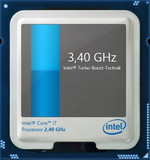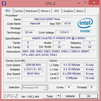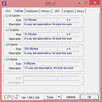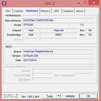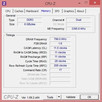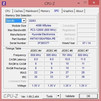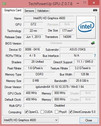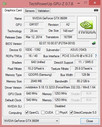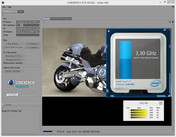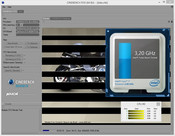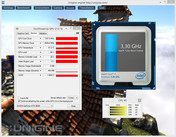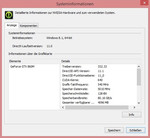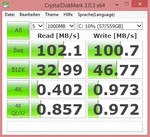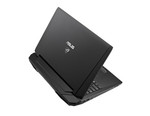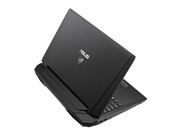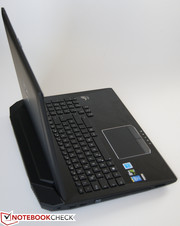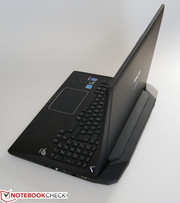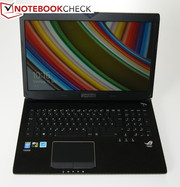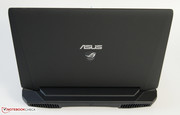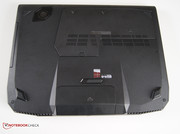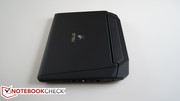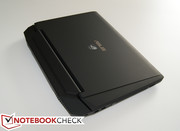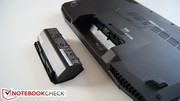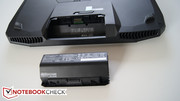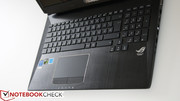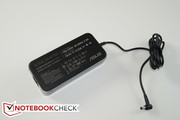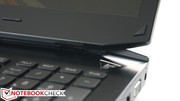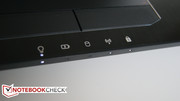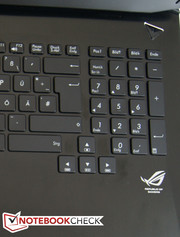Asus G750JM-T4014H Notebook Review Update
For the original German review, see here.
People who are looking for a high-performance gaming notebook and do not want to invest more than 1,500Euros (~$2041) should have a closer look at the Asus G750JM.
While the G750JZ (GTX 880M) and the G750JS (GTX 870M) are equipped with more powerful Nvidia GPUs, the test device has to make do with the significantly less performing GTX 860M. Further features are eight GB DDR3-RAM, a 1,500 GB large HDD and Windows 8.1 64-bit. It comes as no surprise that a quad-core processor is integrated in the design, namely the Intel Core i7-4700HQ (2.4-3.4 GHz). Due to the Blu-ray player, the 17-inch display can show high-resolution movies and thus entertainment fans will be convinced by the G750JM.
According to the web store cyberport.de, that provided us with the test device, the G750JM-T4014H costs 1,400 Euros (~$1905). In comparison: the G750JS costs at least 1,600 Euros (~$2177) (G750JZ: starting at 2,000 Euros (~$2721)). Due to the identical casing, there will be no comments on the equipment and input devices. Corresponding details can be found in this review link.
Display
Similar to the other models, the G750JM has an anti-glare full HD display with 1920x1080 pixels. Even though Asus uses the term “Wide View” on its website, the viewing angles are not outstanding. This is no surprise, considering that the manufacturer does not use IPS technology, which is only slowly gaining use in 17-inch devices.
| |||||||||||||||||||||||||
Brightness Distribution: 93 %
Center on Battery: 286 cd/m²
Contrast: 502:1 (Black: 0.57 cd/m²)
ΔE ColorChecker Calman: 5.39 | ∀{0.5-29.43 Ø4.79}
ΔE Greyscale Calman: 5.79 | ∀{0.09-98 Ø5}
58% AdobeRGB 1998 (Argyll 1.6.3 3D)
64.9% AdobeRGB 1998 (Argyll 3D)
88.8% sRGB (Argyll 3D)
68.1% Display P3 (Argyll 3D)
Gamma: 2.55
CCT: 6968 K
In other categories, the embedded AU Optronics panel (B173HW02 V1) can also score only average results. Next to mediocre black levels, the contrast of 500:1 is neither good nor bad.
In terms of illumination, the AU Optronics lines up behind some competitors. 277 cd/m² are exceeded by the 17-inch Chi Mei N173HGE (see for example the One K73-4N). Due to the limited reflections, the G750JM is suited for outdoor use. Our photos show the visibility at different positions. By the way, illumination of the test device was rather poor (patchy black image).
The color profile deserves a great deal of praise. As one of the exceptions, the G750JM does not show any large signs of blue cast, which is shown by the screenshots of the professional software CalMAN. Saturation and color precision can convince next to the RGB-balance and the grayscales. Only photo and video experts will find one or two flaws. Similarly, the color space of 79% sRGB and 58% AdobeRGB are more than favorable for a gaming notebook.
Performance
Processor
The Intel processor is part of the Haswell generation. Unlike the identically clocked Core i7-4700MQ, the Core i7-4700HQ is tightly connected to the mainboard and is therefore not exchangeable. According to the load, the quad-core processor reaches a speed of 2.4 to 3.4 GHz, where the turbo-boost feature works at its full capacity (more on that later).
Besides, the Core i7-4700HQ inherits all advantages and disadvantages of the Haswell architecture. 22 nm width is just as modern as the six MB large L3 cache. Via Hyperthreading, the CPU can treat up to eight threads simultaneously. Only the heat management can be judged critically. Intel’s high-end chips are known for their high temperature generation.
Thumbs up: unlike the previous models (G750JW, G750JX & G750JH), the manufacturer has finally implemented an Nvidia Optimus technology. Due to the graphics switching, the 17-inch notebook saves a lot of energy, which is beneficial for battery life.
Turbo Boost
Automatic processor overclocking is fully used. 3.2 to 3.4 GHz for single core and 3.0 to 3.2 GHz for multi-core applications are very impressive. CPU and GPU throttling however, is not used in the high-end notebook. Even under full load, Turbo-mode is always active.
CPU Performance
The results of the Cinebench R15 are strongly based on the G750JS and the G750JZ, which are equipped with a Core i7-4700HQ as well. Considering 132 points on the single CPU test and 642 points for the multi CPU test, it becomes obvious that the more expensive chips are hardly worth using. The Core i7-4800MQ for example, is only 3-8% faster. The advantage the Core i7-4910MQ offers with 9-16% is also relatively small. For gamers, every quad-core model is now sufficient.
| Cinebench R15 | |
| CPU Single 64Bit (sort by value) | |
| Asus G750JM | |
| Alienware 17 | |
| One K73-4N | |
| MSI GT70 | |
| Schenker XMG P704 | |
| CPU Multi 64Bit (sort by value) | |
| Asus G750JM | |
| Alienware 17 | |
| One K73-4N | |
| MSI GT70 | |
| Schenker XMG P704 | |
| Cinebench R11.5 | |
| CPU Single 64Bit (sort by value) | |
| Asus G750JM | |
| Alienware 17 | |
| One K73-4N | |
| MSI GT70 | |
| Schenker XMG P704 | |
| CPU Multi 64Bit (sort by value) | |
| Asus G750JM | |
| Alienware 17 | |
| One K73-4N | |
| MSI GT70 | |
| Schenker XMG P704 | |
Graphics Card
Contrary to expectations, Asus does not resort to the Kepler GeForce GTX 860M for its G750JM, but to the Maxwell version. Admittedly, the Maxwell version has around 50% less shader units (640 vs. 1,152), but due to the higher clocking rates (1,029-1097 vs. 797-915 MHz) and general efficiency improvements, it works faster.
Asus goes even one step further and overclocks the GTX 860M. According to the GPU-Z tool, 1,197 MHz is possible for 3D operations, which correspond to a 10% higher value. Our graphics benchmarks clearly indicate that this increase has also advantages in practice.
Independent of the clock rate, the GTX 860M offers a large 2,048 MB 128-bit GDDR5 video memory. Since there are already games which ask for three or more gigabytes (Watch Dogs, Wolfenstein: The New Order), passionate gamers are only satisfied with a GeForce GTX 870M or GeForce GTX 880M. Nevertheless, regardless of whether Kepler or Maxwell: the current Nvidia generation is designed in a 28-nm-process.
GPU Performance
Depending on the benchmark, the increased core clock pays off - sometimes more, sometimes less; for example, the Fire-Strike-test, where the 3DMark 13 assigns a GPU score of 4,199 to the Asus G750JM. With that, the 17-inch notebook is 6% better than a normally clocked GTX 860M notebook (3,947 points @ Nexoc G728II). The GTX 850M GDDR5 lags by 14% (3,596 points @ MSI GE70). The Kepler version of the GTX 860M looses even 24% (3,174 points @ Schenker W504). Overclocking allows the G750JM to come close to a notebook with a GTX 870M (4,701 points @ MSI GT60).
Similar differences are revealed by the Unigine Heaven 3.0 benchmark that we tested with 1920x1080 pixels and normal tessellation. 53.9 fps form approximately the average of GTX 870M and GTX 860M Kepler, which reach 64.4 and 45.2 fps, respectively. A GTX 850M GDDR5 and a GTX 860M with standard clocking fall behind by 8 to 15%.
| Unigine Heaven 3.0 - 1920x1080 DX 11, Normal Tessellation, High Shaders AA:Off AF:Off (sort by value) | |
| Asus G750JM | |
| Schenker W504 | |
| MSI GE70 | |
| Nexoc G728II | |
| MSI GT60 | |
| 3DMark - 1920x1080 Fire Strike Graphics (sort by value) | |
| Asus G750JM | |
| Schenker W504 | |
| MSI GE70 | |
| Nexoc G728II | |
| MSI GT60 | |
| 3DMark 11 - 1280x720 Performance GPU (sort by value) | |
| Asus G750JM | |
| Schenker W504 | |
| MSI GE70 | |
| Nexoc G728II | |
| MSI GT60 | |
| 3DMark Vantage - 1280x1024 P GPU no PhysX (sort by value) | |
| Asus G750JM | |
| Schenker W504 | |
| MSI GE70 | |
| Nexoc G728II | |
| MSI GT60 | |
| 3DMark Vantage P Result | 20492 points | |
| 3DMark 11 Performance | 5545 points | |
| 3DMark Ice Storm Standard Score | 107407 points | |
| 3DMark Cloud Gate Standard Score | 16389 points | |
| 3DMark Fire Strike Score | 3907 points | |
Help | ||
Storage Devices
In consolation for the missing SSD, Asus integrates a 1,500 GB large HDD. Even though the magnetic storage rotates at only 5,400 rpm, performance can be considered decent. The 100 MB/sec sequential write and read test of the CrystalDiskMark are just as good as 82 MB/sec in HD Tune.
Of course the HGST Travelstar 5K1500 cannot reach the speed of a solid-state drive, which normally reaches the 200-MB mark. In addition to the improved booting speed, an SSD would also decrease access time.
System Performance
Considering everything, the G750JM has a respectable system performance, where 3,570 points for the PCMark 7 are not very impressive and also achieved by older and less performing notebooks (e.g., the Alienware M14x). For higher scores, Asus should integrate a SSD.
| PCMark 7 Score | 3570 points | |
| PCMark 8 Home Score Accelerated v2 | 3509 points | |
| PCMark 8 Creative Score Accelerated v2 | 4837 points | |
| PCMark 8 Work Score Accelerated v2 | 4028 points | |
Help | ||
Gaming Performance
By analogy with the synthetic graphics benchmarks, gaming tests were performed with the preinstalled driver 332.33. The driver ensures good performance, but for new games, one should switch to a more recent version. GRID: Autosport for example, did not allow for full screen.
Considering the frame rates of Watch Dogs, Wolfenstein: The New Order and The Elder Scrolls Online and comparing them with other GTX-860M devices (low to high settings), one can see that the G750 JM could profit from a driver update. At maximum settings, the power of the graphics card is limiting.
If anti-aliasing is not exaggerated, almost all titles can be played smoothly with the initial resolution. Only in some extreme cases like Far Cry 3, best quality settings are taboo (high details and 2x AA are mostly working judder-free).
| Call of Duty: Ghosts - 1920x1080 Extra / High / HBAO+ / No dynamic fur AA:4x MS (sort by value) | |
| Asus G750JM | |
| Schenker W504 | |
| MSI GE70 | |
| Nexoc G728II | |
| MSI GT60 | |
| low | med. | high | ultra | |
|---|---|---|---|---|
| Guild Wars 2 (2012) | 115 | 60.7 | 32 | |
| Far Cry 3 (2012) | 108.1 | 97.8 | 66.2 | 24.4 |
| Dota 2 (2013) | 117.7 | 110.8 | 89.8 | |
| Saints Row IV (2013) | 68.6 | 60.3 | 51.3 | 36.3 |
| Call of Duty: Ghosts (2013) | 88.8 | 82.7 | 55.4 | 32.9 |
| The Elder Scrolls Online (2014) | 87.8 | 79.3 | 67.8 | 40.7 |
| Wolfenstein: The New Order (2014) | 60 | 59.9 | 54.7 | |
| Watch Dogs (2014) | 60.7 | 52.8 | 28.4 | |
| GRID: Autosport (2014) | 151.9 | 96.2 | 72.4 | 47.2 |
Emissions
System Noise
It could be anticipated that the G750JM is one of the most silent 17-inch notebooks at low operating loads. Almost none of the high-end notebooks behaves silently, may it be for simple tasks or 3D applications. The 32-33 dB(A) noise level when idle is close to the G750JS and G750JZ, which both reach just over 30 dB(A).
Larger differences can be noted for 3D operations. Instead of 41 dB(A), a constant 38 dB(A) was measured during 3DMark 06. In general, fan control leaves a good impression. The fans are very dynamic during load changes and they work without any significant jumps.
When the notebook does not perform any tasks and various energy-saving options are active, the fan shuts almost completely down and only a small whooshing of the HDD is audible. The Blu-ray-Combo turns out to be a little annoying: when playing the test DVD, the Matshita BD-CMB UJ160 made some noises, a kind of small whirring.
Under extreme conditions, 47 dB(A) could be recorded, which is also acceptable for the gaming segment. Other high-end notebooks exceed the 50 dB(A) mark during stress test (MSI GT60, One K56-4N, Schenker XMG A504...).
Noise level
| Idle |
| 30.8 / 32.2 / 32.8 dB(A) |
| HDD |
| 31 dB(A) |
| DVD |
| 38 / dB(A) |
| Load |
| 38.2 / 47.4 dB(A) |
 | ||
30 dB silent 40 dB(A) audible 50 dB(A) loud |
||
min: | ||
Temperature
Despite the slower graphics accelerator, the chassis values are similar to the G750JS, which stays slightly cooler at an ambient temperature of 24 °C (75.2 °F; this could be related to the different measuring device).
Average temperatures of 30 °C when Idle and 32 °C (top) and 37 °C (bottom) for 3D operations (86, 89.6 and 98.6 °F respectively) are respectable for a gaming notebook. While the comparably equipped Nexoc G728II shows similar temperatures, significantly higher values were obtained for the flatter MSI GE70 (a maximum of 58 instead of 45 °C (113 °F) within the fan area).
The components do not heat up too much. Admittedly, the stress test of the Core i7-4700HQ with the FurMark and Prime95 tools yield values up to 93 °C (199.4 °F, CPUID HWMonitor), but 73 °C (163.4 °F) for the graphics chip are relatively low. The GTX 870M of the G750JS reached a definitively higher value of 88 °C (190.4 °F). It is similar for the Nexoc G728II (max. 80 °C @ GTX 860M) and the MSI GE70 (max. 92 °C @ GTX 850M; 176 and 197.6 °F respectively). Thus, the massive cooling construction of the G750JM, which cannot be cleaned easily, serves its purpose.
(+) The maximum temperature on the upper side is 38 °C / 100 F, compared to the average of 40.5 °C / 105 F, ranging from 21.2 to 68.8 °C for the class Gaming.
(±) The bottom heats up to a maximum of 44.8 °C / 113 F, compared to the average of 43.3 °C / 110 F
(+) In idle usage, the average temperature for the upper side is 30.1 °C / 86 F, compared to the device average of 33.9 °C / 93 F.
(+) The palmrests and touchpad are cooler than skin temperature with a maximum of 28.7 °C / 83.7 F and are therefore cool to the touch.
(±) The average temperature of the palmrest area of similar devices was 28.9 °C / 84 F (+0.2 °C / 0.3 F).
Speakers
For the sound category, we would like to refer you to the G750JS.
Energy Management
Power Consumption
In comparison to the previous generation, energy consumption has noticeably decreased. While the G750JX drained 23-31 Watts at no-load condition, it is only 13-26 Watts for the G750JM.
Under load, the new model is also more efficient, even though the GTX 860M is ranked just before the GTX 770M. The 83 Watts registered are a savings of 14% over the 96 Watts in 3DMark 06 and testify to the improved efficiency of the Maxwell architecture. The value at full load is lower compared to its predecessor (147 vs. 164 Watts).
| Off / Standby | |
| Idle | |
| Load |
|
Key:
min: | |
Battery Life
The advantages of the graphics switching can be especially noted when the device is running on battery. The maximum six hours that the G750JX achieved just one year ago is a piece of cake for the G750JM.
Using maximum energy savings and the lowest brightness, the G750JM can last for eight hours without the power adapter. Around 5.5 hours wireless browsing (medium brightness) and 4.5 hours of DVD playback are also impressive.
Only for 3D operations with an active Nvidia chip causes the 17-inch notebook not to last that long: 1.5 hours prevent the G750JM from scoring a higher score for battery life. In general, the 89 Wh of the 8-cell battery indicate a generously designed device. Most manufacturers include inferior and thus cheaper models in their notebooks.
Verdict
If you are looking for a rather silent gaming notebook, you should go for the Asus G750JM. Admittedly, the GeForce GTX 860M – despite overclocking and Maxwell architecture – cannot compete with the top sellers GTX 870M and GTX 880M (Kepler technology). The performance, however, should be enough for occasional gamers.
The individually designed chassis depends on taste. While person x might appreciate the cooling system, person y will rail against the modest maintenance options and the enormous weight. It is not pleasant to carry around four kilograms (~8.8 pounds).
In terms of battery life, the G750JM is above average. Other positive aspects are the illuminated keyboard and the touchpad. Processing, equipment and sound quality are in accordance with the price, whereby now one could expect an SSD for a 1400 Euros (~$1905) notebook.
The most unique characteristic is the moderate noise generation. Hardly any notebook stays as cool and silent during gaming as the G750JM. This makes up for the large height of five centimeters (~2 inches) and a second-class Wi-Fi adapter.
If you are not able to make compromises in terms of image quality (anti-aliasing, etc.), you should however, go for another device. Several alternatives can be found in the “Shortcut” (right column).















